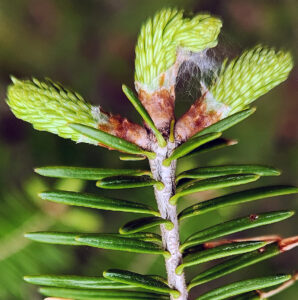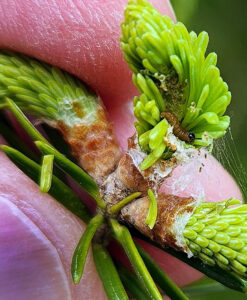
Young spruce budworm larvae begin feeding as buds break, causing the new growth to crook where feeding damage occurs. Webbing is also common. / Photo Credit: Linda Williams, Wisconsin DNR
By Linda Williams, Wisconsin DNR Forest Health Specialist
Linda.Williams@wisconsin.gov or 920-360-0665
From early indications, the spruce budworm outbreak in some areas of northern Wisconsin is preparing to continue for yet another year.
During the third week of May, expanding buds on balsam fir trees were already showing damage from the tiny larvae.
Spruce budworm overwinters as a tiny caterpillar that begins feeding as soon as buds begin to swell. Early feeding can cause expanding buds to curl slightly into a half-moon shape, and larvae may web together across two or more buds to feed safely within the webbing.

By pulling apart the webbing on a spruce branch to examine new growth, a tiny, brown spruce budworm caterpillar can sometimes be found using its black head to feed within the expanding buds. / Photo Credit: Linda Williams, Wisconsin DNR
Older larvae continue to feed on new needles and can web together pieces of needles that will remain on the tree into the summer, turning the needles a reddish-brown color that gives the trees a scorched appearance from a distance.
The Wisconsin Department of Natural Resources offers a spruce budworm fact sheet with more information on biology and management.
